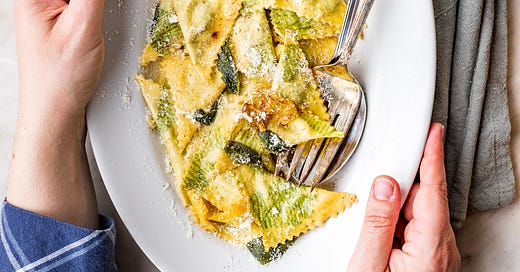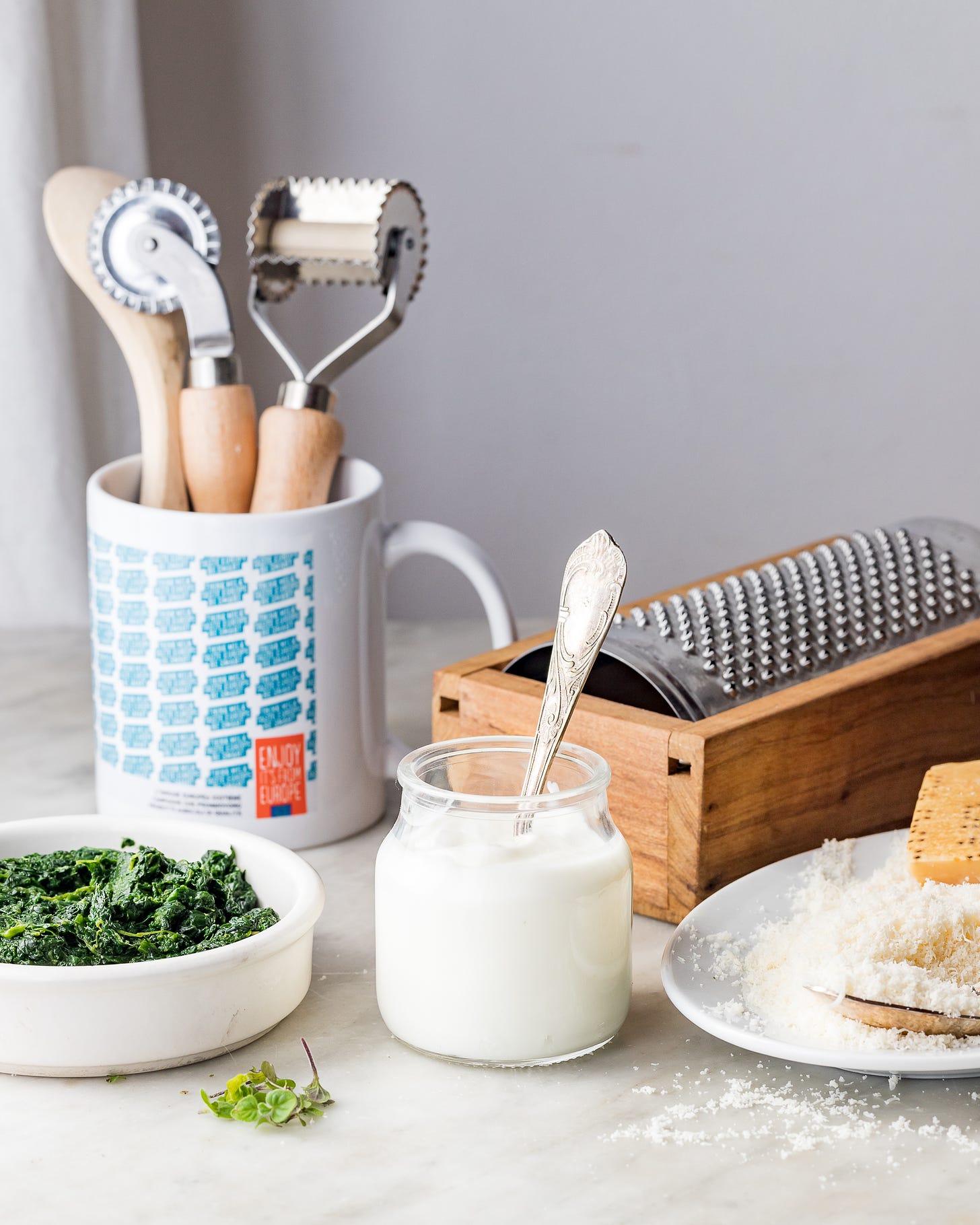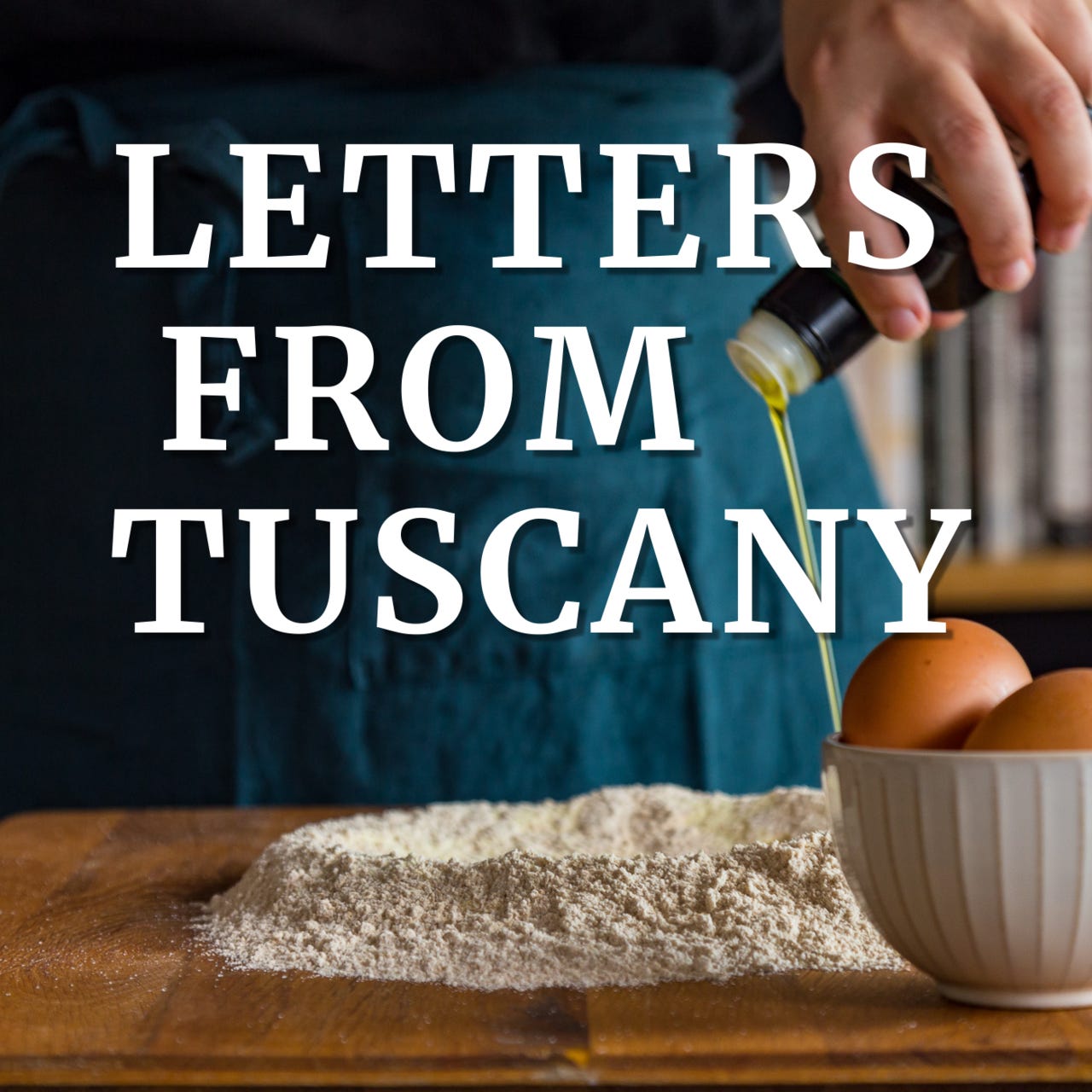The same old tortelli, but with something unusual
A spring-like fresh pasta dish with a refreshing and slightly tart taste: spinach and strained yoghurt tortelli, tossed in brown butter, sage, and lemon zest.
I often rely so much on family traditions and on what I have known since I was a kid that I forget how invigorating it can be to vary, even if for just one single ingredient.
I was in the mood for a spring-like homemade pasta dish, with a fresh and slightly tart taste, just like those early spring days when the weather is still uncertain and the air brimming with expectation.
So I made the same old tortelli, but with something unusual, at least for me.
Working on the filling, I replaced ricotta with strained yoghurt, then I followed tradition, and mixed it with spinach sautéed in butter, grated Parmigiano Reggiano, nutmeg, and marjoram.
The delicate acidity of the strained yoghurt creates an unusual dish disguised as a family classic, and its tart flavour cuts through the rich dressing made of browned butter, sage, and lemon zest.
The dressing fully embraces tradition - ricotta and spinach tortelli here are almost always served with butter and sage, one of the very few Tuscan recipes in which butter is required - but has that extra something given by the lemon zest, cut into strips, which fries in melted butter along with fresh sage leaves.
The unusual ingredient: strained yoghurt
To strain the yoghurt, place a strainer over a larger bowl and line it with a cheesecloth or with a clean white kitchen towel.
Pour the yoghurt into the strainer and make sure that the strainer has plenty of room underneath to let the yoghurt drip without being submerged in the liquid it will release. The next morning you will find a thick, creamy, almost spreadable yoghurt in the strainer, about half the amount of the quantity you started with.
In the bowl, you will be left with whey. Don't discard it, as it has so many uses in the kitchen. You can use it to knead a focaccia - the whey will give it a slightly acidic taste as if you had used sourdough - to dilute a smoothie, or to marinate white meat such as chicken or turkey before roasting: it will make the meat softer and tastier.
This recipe for spinach and strained yoghurt tortelli was developed as part of the Think Milk, Taste Europe, Be Smart project, aiming to raise awareness of the high European standards and the great tradition of dairy products in Europe. We focused on one of the most transversal dairy products in Europe, yoghurt. One of the protagonists of our porridge or granola breakfasts when we were on our honeymoon in Ireland, mixed with grated cucumber, olive oil, and garlic in a delicious tzatziki at my friend Tessa's during a Greek dinner, a key ingredient in Eastern European gastronomy and one of the first snacks I gave Livia when she was weaned, yoghurt made in the EU is a concentration of culture, customs and traditions, a product whose quality and safety are guaranteed by European standards and mandatory traceability.
Spinach and strained yoghurt tortelli
A springtime fresh pasta dish with a refreshing and slightly tart taste: spinach and strained yoghurt tortelli, tossed in brown butter, sage, and lemon zest.
Serves 4
For the filling
400 g whole milk yoghurt
200 g spinach, already cooked and squeezed
20 g butter
40 g Parmigiano Reggiano, grated
2 teaspoons fresh marjoram leaves
Nutmeg, grated
Fine sea salt and freshly ground black pepper
For the fresh pasta
100 g all-purpose flour
100 g semolina flour
2 eggs
¼ teaspoon fine sea salt
½ tablespoon extra virgin olive oil
1 handful parsley leaves, optional
For the dressing
100 g butter
Zest of 1 organic lemon
20 sage leaves
Parmigiano Reggiano, grated
Make the filling.
The day before, line a fine-mesh strainer with a cheesecloth or with a clean white kitchen towel. Pour in the yoghurt and place the strainer in a larger bowl so that the strainer does not touch the bottom. Cover the yoghurt with cling film and put it in the fridge to strain overnight.
The next morning, the yoghurt in the strainer will be thick and creamy, like a spreadable cheese, or Greek yoghurt, while in the bottom of the bowl you will find the whey. Don't throw it away, you can use it in many other recipes.
Finely chop the spinach, place it in a small frying pan and cook over medium heat with butter for 5 minutes. Let it cool down completely.
In a bowl, mix the spinach with the strained yoghurt, grated Parmigiano Reggiano, marjoram, and grated nutmeg. Taste and season with salt and pepper.
Store the filling in the refrigerator until ready to use.
Make the fresh pasta.
Pour the flour and semolina on a work surface and shape into a mound with a large well in the centre. Add the eggs, salt, and olive oil. Using a fork, stir slowly, starting from the centre and gradually picking up more flour from the edges. When the dough turns crumbly, switch to kneading with your hands.
Continue kneading the ball of dough until the gluten starts to develop, as this will render the sheets of pasta more elastic. Alternatively, consider kneading the dough in a mixer with the dough hook for about 10 minutes on low speed, then finish kneading by hand for 5 minutes.
When the ball of dough is smooth, silky, and no longer sticky, cover with a bowl, and let rest for 30 minutes at room temperature.
Make the tortelli.
Lightly flour a work surface with semolina flour and, with a rolling pin, roll out one piece of dough into a ½-inch/1 cm-thick rectangle. Keep the remaining pieces covered with a clean kitchen towel.
Whether you’re using a classic long rolling pin or a pasta machine, the most important thing is to roll it over and over again, rolling and stretching it as much as you can. Make a paper thin wide sheet of pasta.
Scatter half of the pasta sheet with parsley leaves, fold it over itself and pass it through the pasta machine once more.
Cut the sheet of pasta into 2½-inch/6 cm squares. Collect any scrap of pasta dough and add it back to the dough covered with the kitchen towel.
Spoon 1 heaping teaspoon of filling into the centre of each disc, then fold it to form a triangle. Press the edges to seal the filling inside, trying to remove as much air as possible. Using the backside of a fork, press the long edges of each raviolo to seal. Transfer the formed ravioli to a tray dusted with semolina flour; cover with a clean, dry kitchen towel.
Repeat the rolling process with the remaining pieces of dough until you’ve used all of the filling.
Cook the tortelli.
Bring a large pot of salted water to a boil over high heat. While the water heats, melt the butter in a medium frying pan over medium-low heat. When the butter stops foaming, add the leaves and lemon strips and fry, stirring, for a couple of minutes. Set aside.
When the water is boiling, add the ravioli in batches and cook for 3 to 5 minutes, until they float. Remove from the water with a slotted spoon and transfer to a serving dish.
When all of the ravioli have been cooked, drizzle them with the reserved melted lemon and sage butter, sprinkle with grated Parmigiano Reggiano, and serve immediately.
If you decide to participate in the weekend cooking project, share the results with us on social media by using the hashtag #myseasonaltable and tagging @julskitchen on Instagram.
If you have questions about the ingredients or the recipe, if you have a special request for one of the following cooking projects, or want to have a chat, reply to this email or leave a comment.
The new Substack App!
I have exciting news to share: You can now read Letters from Tuscany in the new Substack app for iPhone.
I have been waiting for this feature since I started reading many newsletters: I wanted an app where I could easily read all my favourite food writers, and now, there it is!
With the app, you’ll have a dedicated Inbox for my Substack and any others you subscribe to. New posts will never get lost in your email filters or stuck in spam. Longer posts will never be cut-off by your email app. Comments and rich media will all work seamlessly. Overall, it’s a big upgrade to the reading experience.
The Substack app is currently available for iOS. If you don’t have an Apple device, you can join the Android waitlist here.
Support us by joining our paid newsletter
[If you already subscribed to our newsletter, thank you!]
When you join our subscription-based newsletter, you are actively contributing to the making of Letters from Tuscany, granting us the time, energy, and resources to research, test and re-test, and photograph the recipes, to write the stories and the interviews, to film the videos that we share here. You are part of the reason why we keep cooking, writing, and sharing, so thank you.
Letters from Tuscany is your anchor to Italy, to the Italian table and our loud conviviality, a reason to experiment with lesser-known ingredients, the voice of a friend in the kitchen.
What you missed recently: Florentine rice fritters, Pasta alla puttanesca, Ciaccino with ham and mozzarella, Leek and potato soup, Pittule salentine.
Whenever you decide to join us, you will have complete access to the whole archive of already published recipes and stories.









